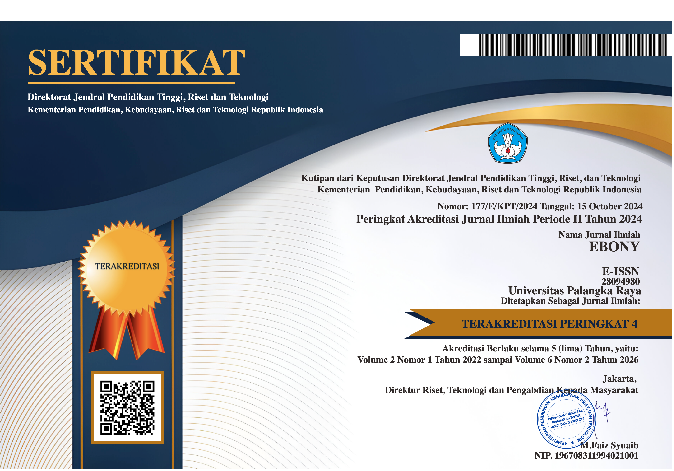Indonesian University Students’ Attitudes and Aspirations Towards ICT in EFL Learning
DOI:
https://doi.org/10.37304/ebony.v3i1.7997Keywords:
ICT, EFL learning, attitude, aspirationsAbstract
The Information and Communication Technology (ICT) has been widely used in learning a language and it seems to influence learners’ attitude on learning a language. Therefore, this study is intended to reveal Indonesian University students’ attitudes on the use of ICT in EFL learning. The data were collected from 152 second-year students on English education program who contributed in an online-survey and 4 of them were involved in a semi-structured interview. To obtain the objective, a mixed-methods research design was applied. The result indicated that Indonesian university students have a high positive attitude towards the application of ICT in their EFL learning.
Downloads
References
Afshari M., Ghavifekr, S., Siraj, S., Jing, D. (2013). Students’ attitudes towards computer-assisted language learning. Procedia- Social and Behavioral Sciences, 103, 852-859. doi: 10.1016/j.sbspro.2013.10.407
Agca K. R., Ozdemir S. (2013). Foreign language vocabulary learning with mobile technologies. Procedia-Social and Behavioral Sciences, 83, 781-785. doi: 10.1016/j.sbspro.2013.06.147
Ali, A.Z., Segaran, K., Hoe, T.W. (2015). Effects of Verbal Components in 3D Talking-head on Pronunciation Learning among Non-native speakers. Educational Technology & Society, 18(2), 313-322. Retrieved from https://www.jstor.org/stable/pdf/jeductechsoci.18.2.313
Alkash, K. A. M. & Al-dersi, Z. E. M. (2013). Advantages of Using PowerPoint Presentation in EFL Classroom & the Status of its Use in Sebha University. International Journal of English Language & Translation Studies (IJ-ELTS), 1(1), 61-71. Retrieved from http://www.eltsjournal.org/archive/value1%20issue1/2-1-1-13.pdf.
Alsied, S.M. & Pathan, M.M. (2013). The Use of Computer Technology in EFL Classroom: Advantages and Implications. International Journal of English Language & Translation Studies (IJ-ELTS), 1(1), 61-71. Retrieved from http://eltsjournal.org/archive/value1%20issue1/6-1-1-13.pdf.
Ashraf, H., Motlagh, F.G., Salami, M. (2014). The Impact of Online Games on Learning English Vocabulary by Iranian (Low-intermediate) EFL learners. Procedia- Social Behavioral Sciences, 98(2014), 286-291. doi: 10.1016/j.sbspro.2014.03.418.
Aşkar, P., Yavuz, H., Köksal, M. (1992). Students’ perceptions of computer assisted instruction environment and their attitudes towards computer assisted learning. Educational Research, 34(2), 133-139, doi: 10.1080/0013188920340204.
Awada, G. & Ghaith. G. (2014). Impact of Using the WebQuest Technological Model on English as a Foreign Language (EFL) Writing Achievement and Apprehension. Arab World English Journal (AWEJ), special issue (1), 81-93, Retrieved from http://www.awej.org/images/AllIssues/Specialissues/CALLjuly2014/6.pdf.
Azar, A. S. & Nasiri, H. (2014). Learners’ Attitudes toward the Effectiveness of Mobile Assisted Language Learning (MALL) in L2 Listening Comprehension. Procedia-Social and Behavioral Sciences, 98(2014), 1836-1843. doi: 10.1016/j.sbspro.2014.03.613
Baz, E. H., (2016). Attitudes of Turkish EFL Student Teachers towards Technology Use. The Turkish Journal of Educational Technology (TOJET), 15(2), 1-10. Retrieved from http://files.eric.ed.gov/fulltext/EJ1096409.pdf
Bryman, A. (2016). Social Research Methods (5th Ed.) Oxford: Oxford University Press.
Buga, R., Capeneata, I., Chirasnel, C., & Popa, A. (2013). Facebook in foreign language teaching-a tool to improve communication competences. Procedia-Social and Behavioral Sciences, 128(2014), 93-98. doi: 10.1016/j.sbspro.2014.03.124.
Celik, S. & Aytin, K. (2014). Teachers’ Views on Digital Educational Tools in English Language Learning: Benefits and Challenges in the Turkish Context. The Electronic Journal for English as a Second Language (TESL-EJ), 18(2). Retrieved from http://www.tesl-ej.org/wordpress/issues/volume18/ej70/ej70a1.
Cheng, L.L., Puteh, F., Selamat, A., & Mohamed, F.B. (2015). A review of recent usability measures in English Language Teaching (ELT) technologies. 9th Malaysian Software Engineering Conference (MySEC) (pp. 278-283), Malaysia: Kuala Lumpur, doi: 10.1109/MySEC.2015.7475233.
Chik, A.C. (2014). Digital Gaming and Language Learning Autonomy and Community. Language Learning & Technology, 18(2), 85-100, Retrieved from http://llt.msu.edu/issues/june2014/chik.pdf
Diana, AT & Ciornei, SI. (2013). The Advantages and Disadvantages of Computer Assisted Language Learning and Teaching for Foreign Languages. Procedia-Social and Behavioral Sciences 76(2013), 248-252. doi: 10.1016/j.sbspro.2013.04.107.
Dörnyei, Z & Taguchi, T. (2010). Questionnaires in Second Language Research: Construction, Administration, and Processing (2nd Ed.). New York: Routledge
Dörnyei, Z. (2003). Questionnaires in Second Language Research. Construction, Administration, and Processing. Mahwah: Lawrence Erlbaum Associates.
Duarte, A.M. (2007). Conceptions of learning and approaches to learning in Portuguese students. Higher Education, 54(6). 781-794. doi: 10.1007/s10734-006-9023-7
Fauzi, I., Hartono,R., Widhiyanto, W., & Pratama, H. (2022). Web-Based Language Learning: Benefits for Enhancing EFL Learners’ Speaking Skill. International Conference on Science, Education, and Technology, 8(1), 192–196. Retrieved from https://proceeding.unnes.ac.id/index.php/ISET/article/view/1749
Franciosi, S.J. (2017). The Effect of Computer Game-Based Learning on FL Vocabulary Transferability. Journal of Educational Technology & Society, 20(1), 123-133. Retrieved from http://www.jstor.org/stable/jeductechsoci.20.1.123.
Golonka, E.M., Bowles, A.R., Frank, V.M., Richardson, D.L., & Freynik, S. (2014). Technologies for foreign language learning: a review of technology types and their effectiveness. Computer Assisted Language Learning, 27(2), 70-105, doi: 10.1080/09588221.2012.700315.
Götz, S. (2015). Fluency in ENL, ESL, and EFL: A corpus-based pilot study. Proceedings of Disfluency in Spontaneus Speech, Retrieved from http://www.disfluency.org/DiSS_2015/Programme_files/Goetz-DISS2015.pdf
Grix, J. (2004). The Foundations of Research. Hampshire. Palgrave Macmillan
Halewood, N. & Kenny, C. (2008). Young People and ICTs in developing countries. Information Technology for Development, 14(2), 171-177. doi: 10.1002/itdj.20093
Hammond, M. & Gamlo, N.H. (2015). How and why do language teachers use ICT in a University in Saudi Arabia. Proceedings of Global Learn, 2015 Global Conference on Learning and Technology (pp. 248-257), Germany: Berlin.
Hani, N. A.B. (2014). Benefits and Barriers of Computer Assisted Language Learning and Teaching in the Arab World: Jordan as a Model. Theory and Practice in Language Studies, 4(8), 1609-1615, doi: 10.4304/tpls.4.8.1609-1615.
Hung, HC & Shelley, SC. (2015). The Effectiveness of Adopting E-Readers to Facilitate EFL Students’ Process-Based Academic Writing. Journal of Educational Technology & Society, 18(1), 250-263. Retrieved from http://www.jstor.org/stable/jeductechsoci.18.1.250.
Jayanthi, N.S. & Kumar, R.V. (2016). Use of ICT in English Language Teaching and Learning. Journal of English Language and Literature, 3(2), 34-38. Retrieved from http://joell.in/wp-content/uploads/2016/03/34-38Use-of-ICT-in-English-Language-Teaching.pdf
Johnson, R. B., Onwugbuzie, A. J., & Turner, L. A. (2007). Toward a definition of Mixed Method Research. Journal of Mixed Research, 01(02), 112-133. doi: 10.1177/1558689806298224
Kara, A. (2009). The Effect of a ‘Learning Theories’ Unit on Students’ Attitudes Toward Learning. Australian Journal of Teacher Education, 34(3), 100-113. Retrieved from: http://dx.doi.org/10.14221/ajte.2009v34n.3.5
Keengwe, J. & Hussein, F. (2012). Using computer-assisted instruction to enhance achievement of English Language Learners. Education and Information Technologies, 19(2), 295-306. doi: 10.1007/s10639-012-9214-z
Kim, J., Cho, Y.W., Lee, Y.J. (2014). Exploring the Effects of Multimedia-based Self-directed English-Speaking Practice. Multimedia-Assisted Language Learning (MALL), 17(4), 61-87. doi: 10.15702/mall.2014.17.4.61.
Kurniawan, M. & Tanone, R. (2015). Mobile Learning in TESOL: A Golden Bridge for Enhancement of Grammar Awareness and Vocabulary Mastery. English Education Journals, 19(1), 263-276. Retrieved from https://www.researchgate.net/profile/Mozes_Kurniawan/publication/315683622_Mobile_Learning_in_TESOL_A_Golden_Bridge_for_Enhancement_of_Grammar_Awareness_and_Vocabulary_Mastery/links/58db3ad8a6fdccca1c858b61/Mobile-Learning-in-TESOL-A-Golden-Bridge-for-Enhancement-of-Grammar-Awareness-and-Vocabulary-Mastery.pdf
Lan, Y.J. (2013). The Effect of Technology-Supported Co-Sharing on L2 Vocabulary Strategy Development. Educational Technology & Society, 16 (4), 1–16.
Li, L. (2017). New Technologies and Language Learning. London: Palgrave Macmillan
Li. L & Walsh S. (2010). Teaching uptake in Chinese EFL classes. Language Teaching Research. 15(01). 99-125.
Lockley, T & Hayashi, L.P. (2013). Japanese University Students’ CALL Attitudes, Aspirations and Motivations. CALL-EJ, 13 (1), 1-16. Retrieved from http://callej.org/journal/13-1.html
Mawer, K. (2013). Emerging technologies, emerging minds: digital innovations within the primary sector. In G. Motteram (Eds), Innovations in learning technologies for English language teaching (pp. 17-42). Retrieved from https://www.britishcouncil.org/voices-magazine/the-benefits-new-technology-language-learning.
Mohamad Ali, A. Z., Segaran, K., & Wee Hoe, T. (2015). Effects of Verbal Components in 3D Talking-head on Pronunciation Learning among Non-native Speakers. Educational Technology & Society, 18 (2), 313–322.
Motteram, G. (2013, 18 September). The benefits of new technology in language learning. Retrieved from https://www.britishcouncil.org/voices-magazine/the-benefits-new-technology-language-learning.
Oppenheim, A.N. Questionnaire Design, Interviewing and Attitude Measurement. London: Continuum
Poushter, J. (2016). Smartphone Ownership and Internet Usage Continuous to Climb in Emerging Ecnomies. US: Pew Resarch Center.
Prensky, (2001). Digital Natives, Digital Immigrants Part 1. On the Horizon, 9(5), 1-6. Retrieved from https://doi.org/10.1108/10748120110424816
Rabah, J. (2015). Benefits and Challenges of Information and Communication Technologies (ICT) Integration in Quebec English Schools. The Turkish Online Journal and Education Technology (TOJET), 14(2). Retrieved from http://tojet.net/articles/v14i2/1424.pdf
Seghayer, A. K. (2001). The Effect of Multimedia Annotation Modes on L2 Vocabulary Acquisition: A Comparative Study. Language Learning & Technology. 05(01). 202- 232.
Shen, H., Yuan, Y. & Ewing, R. (2014). English learning websites and digital resources from the perspective of Chinese university EFL practitioners. ReCAL, 27(2), 156-176. doi: 10.1017/S0958344014000263.
Tabor, S. & Yoon, S.Y. (2015). Promoting Information and Communications Technology in Indonesia (ADB Papers on Indonesia No.17). Retrieved from https://www.adb.org/publications/promoting-ict-indonesia
Teo, T. (2007). Attitudes toward computers: A study of post-secondary students in Singapore. Interactive Learning Environments, 14(1), 17-24. Retrieved from: http://dx.doi.org/10.1080/10494820600616406
Troudi, S. (2014). Paradigmatic nature and theoretical framework in educational research. Inspiring Academic Practice, 01(02), Retrieved from https://education.exeter.ac.uk/ojs/index.php/inspire/article/view/25
Wang, B.T., Teng, C.W. & Chen, H.T. (2015). Using iPad to Facilitate English Vocabulary Learning. International Journal of Information and Education Technology, 5(2). 100-104, doi: 10.7763/IJIET.2015.V5.484.
Wang, W. C. & Yeh, Y. (2003). Effects of Multimedia Vocabulary Annotations and Learning Styles on Vocabulary Learning. Calico Journal. 01(01). 131-144.
Yavuz, S. (2005). Developing a technology attitude scale for pre-service chemistry teachers. TOJET, 04(01), 17-25, Retrieved from http://search.proquest.com/docview/1288365100?pq-origsite=gscholar
Yulitriana. (2021). Synchronous or Asynchronous: Students’ Perceptions on Online Learning During the Pandemic. EBONY: Journal of English Language Teaching, Linguistics, and Literature, 1(1), 54–59. https://doi.org/10.37304/ebony.v1i1.3101
Yunus, M. Md., Nordin, N., Salehi, H., Sun, C. H., & Embi, M. A. (2013). Pros and Cons of Using ICT in Teaching ESL Reading and Writing. International Education Studies, 6(7), 119-130. doi: 10.5539/ies.v6n7p119.
Yusuf, M., Adams, C., Dingley, K. (2016). Digital Citizen Participation within Schools in the United Kingdom and Indonesia: An Actor-Network Theory (ANT) Perspective. Information Open Access Journal, 7(4), 1-27. doi: 10.1002/itdj.20093
Downloads
Published
How to Cite
Issue
Section
License
Copyright (c) 2023 Emeral, Dedy Arianto Bannus

This work is licensed under a Creative Commons Attribution 4.0 International License.











